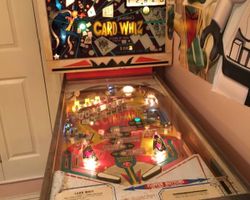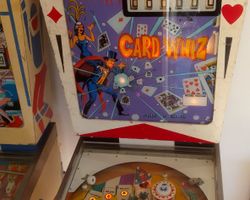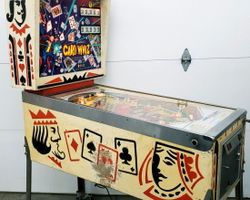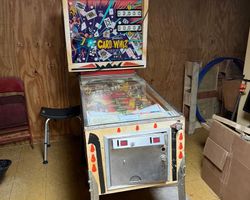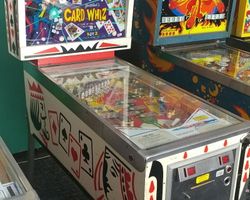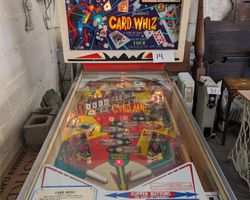Card Whiz
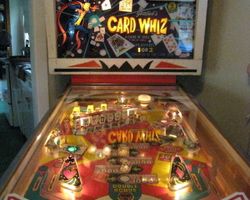
Average Prices: USD $400 to $1,300
Produced: July, 1976
Production Run: 3,250 units
Machine Type: Electro-mechanical
Players: 2
Design by: Ed Krynski
Art by: Gordon Morison
The Gottlieb "Card Whiz" pinball machine, launched in May of 1976, emerged from the D. Gottlieb & Co. factory as a two-player electro-mechanical (EM) game that distilled the essence of card-themed gameplay. Designed by the prolific Ed Krynski, with the artistic vision of Gordon Morison shaping its backglass, Card Whiz aimed to capture the allure of cards and chance, a theme perennially popular in arcades. Gottlieb documentation indicates a confirmed production run of 3,359 units, with 2,030 designated for domestic sale and 1,220 for export markets. This substantial run, preceded by 109 sample games produced in 1975, underscores Gottlieb's confidence in the machine's appeal. Card Whiz also stands as the two-player counterpart to Gottlieb's "Royal Flush" from the same year, sharing a similar playfield layout and core mechanics, yet offering a distinct experience with its focused two-player competition and slightly different artistic interpretation on the backglass.
Signature Features and Design
Card Whiz distinguishes itself through several key design elements that shape its identity and gameplay experience. Central to its appeal is the prominent nine-bank drop target array, which forms the core of its scoring system. These targets, arranged to represent playing cards, directly tie into the machine's primary objective of completing card hands. The satisfaction of hitting these targets, watching them fall, and hearing the accompanying chimes is a foundational pleasure of playing this machine.
Beyond the drop targets, the playfield features a singular pop bumper, strategically placed to add a dynamic element to the upper playfield. This lone bumper ensures that rebounds in that area are unpredictable and can send the ball careening into valuable targets or through rollover lanes. The inclusion of a kick-out hole adds another layer of interaction, often serving as a collection point for bonus awards or skill shots. On the right outlane, a return gate offers a crucial ball-save mechanism, providing a momentary reprieve and prolonging gameplay, a feature appreciated by players seeking extended ball times.
Aesthetic appeal is primarily carried by Gordon Morison’s backglass artwork. Morison’s style captures the classic essence of a card-themed game, featuring a captivating, somewhat enigmatic magician figure surrounded by playing cards. This artwork immediately establishes the machine’s thematic identity, inviting players into its world of chance and skill. While the backglass receives praise for its thematic clarity and classic look, the playfield artwork, typical of its era, offers a more functional and less visually intricate design, prioritizing clear target identification over elaborate scenic elements.
Playfield and Mechanics
The playfield of Card Whiz is laid out with a deliberate non-symmetrical design, contributing to its unique flow and strategic depth. At the heart of the lower playfield are the two flippers, positioned to command a wide range of shots. Directly above these, two slingshots on either side provide lively rebounds, often redirecting the ball towards the upper half of the playfield or back into the flipper area.
The dominant feature is the nine-bank drop target array, positioned centrally and slightly to the upper-right. These targets are arranged to be progressively cleared, mimicking the building of a poker hand, and are pivotal for advancing scores. Surrounding this array are various standup targets, which contribute points and often serve to illuminate specific scoring features or bonus multipliers. A kick-out hole is situated to the upper right, often activated by a precise shot or a rollover lane, awarding bonus points or initiating a new phase of scoring.
The upper playfield is defined by the strategic placement of the single pop bumper. This bumper, combined with a series of rollover lanes, dictates the flow of the ball in this area. Players must navigate these elements to score additional points and potentially open paths to the kick-out hole or other high-value targets. The lanes leading to the flippers are designed to provide challenging returns, requiring precise flipper control to prevent outlane drains. The artwork on the playfield, while functional, uses bold lines and colors to define targets and pathways, ensuring clarity during fast-paced play. Lighting is straightforward, highlighting active targets and score multipliers, adding visual cues to the mechanical score reels located in the backbox, which track scores up to 99,990 points per player.
Gameplay Dynamics
Gameplay on Card Whiz is fundamentally driven by the strategic interplay with its nine-bank drop targets and the pursuit of progressively higher scores. The primary objective revolves around clearing these targets, often in specific sequences, to complete "poker hands" and maximize bonus accumulation. Each target felled contributes to a base score, but the real points come from completing banks or designated groups of targets, which significantly increase the end-of-ball bonus. The rule set encourages players to aim for specific "joker" targets, which act as multipliers, elevating the bonus value when cleared before other card targets. This introduces a tactical layer, as players must weigh the immediate gratification of hitting any target against the long-term benefit of precise, strategic shots.
The single pop bumper in the upper playfield contributes to a dynamic flow, creating unpredictable deflections that can either send the ball into a lucrative target zone or an unexpected drain. Skillful nudging and flipper control are essential to guide the ball through rollover lanes and towards the kick-out hole, which can award significant points or bonus advances. The end-of-ball bonus is a critical component of scoring, building throughout play based on completed target sets and specific lit features, adding a climactic moment before the next ball is launched. The inclusion of a right outlane ball return gate offers a welcome "save," giving players a second chance to re-engage with the playfield and continue their pursuit of high scores. The game can be set for either three or five ball play, allowing operators and players to adjust the challenge and duration. The simple yet effective sound package, featuring three distinct chimes and a satisfying knocker for replays, provides auditory feedback that enhances the classic EM experience.
Reception and Legacy
Card Whiz has garnered a generally positive reception within the pinball community, often praised for its replayability and engaging gameplay. Enthusiasts frequently describe the game as addictive, highlighting the satisfying nature of systematically clearing the drop targets. The game's reliance on these targets, combined with a well-balanced and non-symmetrical playfield layout, is often cited as a key strength. Players appreciate the strategic depth afforded by the rule set, particularly for an electro-mechanical machine, which rewards skilled shot-making and the thoughtful pursuit of bonus multipliers. The classic card theme, coupled with Gordon Morison's backglass artwork and the characteristic Gottlieb EM chimes, contributes to its enduring appeal, creating an atmosphere that many find both nostalgic and compelling. The challenge level, requiring precision and control to master the shots and navigate the outlanes, is also seen as a positive, fostering a desire to improve.
However, Card Whiz is not without its criticisms. Some players find the playfield art to be somewhat generic, lacking the visual flair seen in other machines. A minority of reviewers have described the gameplay as occasionally slow or repetitive, particularly if players fail to engage with the strategic elements and simply shoot at random. Specific points of frustration often include the proximity of inlane guides to the outlanes, which can lead to quick drains, and the perceived randomness of the kick-out hole shot. Despite these minor criticisms, the machine's strengths largely overshadow its weaknesses.
Card Whiz holds a respected place in pinball history as a quintessential Gottlieb EM machine. Its design, attributed to Ed Krynski, exemplifies the company's approach to creating accessible yet challenging games that prioritize fundamental pinball mechanics. Its relationship with "Royal Flush," its four-player sibling, is a notable aspect of its legacy; while Royal Flush often commands more attention due to its higher player count, Card Whiz is sometimes preferred by collectors for its streamlined design and slightly fewer score reels, which can simplify maintenance. It stands as a testament to the era of electro-mechanical design, showcasing how a core set of features, intelligently arranged and integrated with a clear scoring system, can deliver a timeless and satisfying pinball experience. The machine's consistent popularity decades after its release solidifies its position as a cherished example of Gottlieb's output.
Sponsored Links
 Ebay Listings
Ebay Listings
 Auction Results
Auction Results
| Cost | Location | Date |
|---|---|---|
| USD $650 |  Colorado, United States Colorado, United States |
24 July, 2025 |
| GBP £976 |  Potters Bar, United Kingdom Potters Bar, United Kingdom |
03 June, 2025 |
| USD $699 |  Georgia, United States Georgia, United States |
22 May, 2025 |
| USD $3,889 |  Florida, United States Florida, United States |
06 December, 2024 |
| GBP £720 |  London, United Kingdom London, United Kingdom |
16 June, 2024 |
| USD $800 |  Florida, United States Florida, United States |
25 May, 2024 |
| USD $700 |  Pennsylvania, United States Pennsylvania, United States |
27 April, 2024 |
| USD $1,500 |  California, United States California, United States |
26 February, 2024 |
| USD $2,000 |  Florida, United States Florida, United States |
23 February, 2024 |
| USD $600 |  Indiana, United States Indiana, United States |
11 September, 2023 |


Private Policy · Search Website · Contact Us
As an eBay Partner, we may earn a commission from qualifying purchases made through links on this site, at no additional cost to you.
All trademarks and copyrighted materials remain property of their respective owners. All other content copyright 2007 - 2026 Pinpedia.

